Birds of Hawaii: the Hawaiian Honeycreepers
Fringillidae: Finches, Euphonias, and Hawaiian Honeycreepers. The peak of Hawaii’s avian diversity is the group known as Hawaiian honeycreepers, long classified as a family but now understood to be a tribe (the Drepanidini) of finches. Like Darwin’s finches in the Galápagos, but more so, the Hawaiian honeycreepers exemplify adaptive radiation—the phenomenon where one species arrives in an unpopulated environment and begets multiple forms that specialize to occupy different ecological niches.
Of the 39 “drepanidinines” known to have survived until Europeans arrived in Hawaii, 17 have survived into the 2020s. Apart from the widespread Apapane, I’iwi, and Common Amakihi, the other surviving species are single-island endemics: one each on Laysan, Nihoa, and Oahu, three on Maui, four on Kauai, and four on the Big Island. Three of these—the Akikiki, Laysan Finch, and Nihoa Finch—are effectively confined to areas that are off-limits to the general public, while two others—the Akohekohe and Maui Parrotbill—can be seen only through a combination of advance planning and tremendous luck on a privately owned preserve that admits visitors on guided tours about once a month. (For the 22 that did not reach the 2020s alive, see “Birds of Hawaii: Extinct Honeycreepers”.)

Akikiki. (Mohihi Ridge, Alaka’i Wilderness Preserve, Kauai, Hawaii; October 13, 2019.) © Bret Mossman
Endemic to Kauai, where it is a critically endangered resident of wet montane forests. For decades, it was an inconspicuous but fairly common resident at Koke’e State Park. Since the early 2000s it has become a genuine rarity, declining from an estimated population of 6,800 in 1970 to 468 in 2012. Through the 2010s, it was reported sporadically along the Pihea and Alakai Swamp Trails, but seemed increasingly confined to the Alakai Wilderness.
A small, mousy, short-tailed, wrenlike honeycreeper with brownish-gray upperparts, whitish-gray underparts, pink legs, and a short, decurved pink bill. The sexes are similar, but immatures differ in having an extensively whitish face.

Maui Alauahio. (Hosmer Grove, Haleakala National Park, Maui, Hawaii; January 20, 2016.) © Michael Hooper
Endemic to Maui, where it occurs in various forest types at elevations of 900 to 2,500 m on slopes of Mount Haleakala. Locally common at Polipoli Spring, the Waikamoi Preserve, and the Hosmer Grove in Haleakala National Park. Formerly occurred throughout Maui and Lanai, but extirpated from the latter around 1937.
A small, warbler-like honeycreeper with a short straight or slightly decurved bill and remarkably variable plumages. Definitive male plumage is bright golden-yellow overall, duller toward the tail. Female is predominantly a dimmer shade of yellow, with largely olive upperparts. Immatures are medium-gray above and whitish below, with a dark eyeline and pale brow. Subadults show varying amounts and patterns of gray, yellow, and olive.
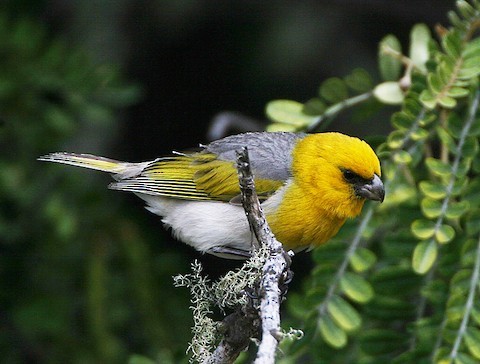
Palila, male. (Pu’u La’au, Big Island, Hawaii; May 7, 2008.) © Michael Walther
Endemic to the Big Island, where it is confined to dry forest on slopes of Mauna Kea in a narrow elevation band between 2,000 and 2,750 m, where its favored food tree, the māmane grows. Endangered but still locally common in its tiny range. It can usually be found at Pu’u La’au, most consistently along the eponymous Palila Forest Discovery Trail, but also along the roads and trails below. Much less common, but found at least occasionally in the open woods around the Mauna Kea Visitor Center above Saddle Road. Formerly much more widespread, including lower elevations and other islands. Fossilized remains have been discovered on Kauai and Oahu.
A large, husky, gray-and-yellow honeycreeper with a rounded, parrotlike bill. Gray overall with a bright-yellow hood and yellow staining in the wings and tail. The sexes are mostly similar, but females have less extensive yellow on the crown, much of it replaced by gray, and males have a blackish mask where females are dark-gray.
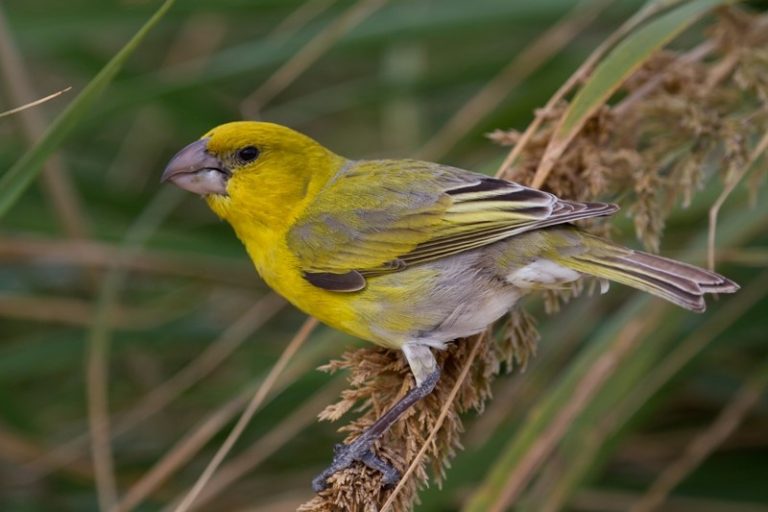
Laysan Finch, male. (Laysan Island, Hawaii.) © Robby Kohley
Endemic to Laysan Island in the Northwest Chain; introduced to Pearl and Hermes Atoll (approximately 400 miles west-northwest of Laysan) on Bird Island and Southeast Island. Common and conspicuous in its tiny range, three extremely remote mid-oceanic islands that rarely receive human visitors except government employees during work assignments.
A large, heavy-billed, grosbeak-like finch. Male has mostly golden-yellow head and breast, and otherwise gray with yellow highlights on the wings, back, and tail. Females resemble males, but are duller yellow and more streaked.
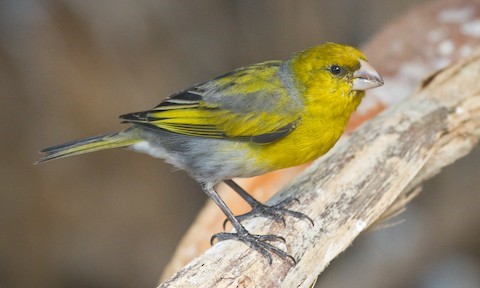
Nihoa Finch, male. (Nihoa, Hawaii; September 8, 2011.) © Eric VanderWerf
Endemic to Nihoa Island in the Northwest Chain. IUCN lists the species as “Critically Endangered” because of its natural vulnerability to catastrophic events in its tiny range. Nevertheless, it remains common on Nihoa, an exceedingly remote, mid-oceanic, 170-acre island that is challenging for boat landings and rarely receives visitors.
A medium-sized, heavy-billed finch. Male has mostly golden-yellow head and breast, and otherwise gray with yellow highlights on the wings, back, and tail. Female is gray-brown, locally suffused with yellow, and finely streaked blackish on the head, upperparts, breast, and flanks.
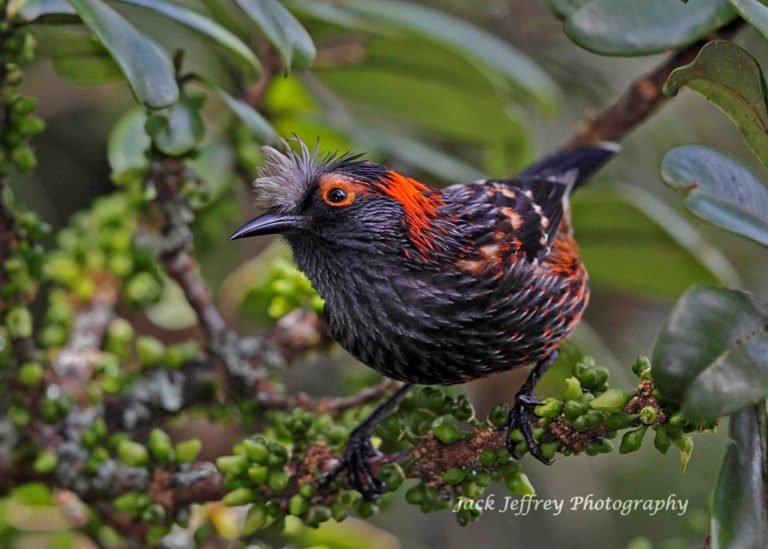
Akohekohe. © Jack Jeffrey
Endemic to Maui, where it is critically endangered and confined to native forests on the northern and eastern slopes of Mount Haleakala in the range of 1,100 to 2,300 m (mainly 1,500 to 2,100 m). Uncommon, with a tiny and mostly inaccessible range, but it can still be found on guided visits to the Waikamoi Preserve. Much less often found in the Hosmer Grove of Haleakala National Park. Formerly also on Molokai, where last reported in 1907.
A unique honeycreeper with a prominent bushy whitish-gray frontal crest and largely black plumage highlighted throughout with white, gray, and orange spots and streaks.
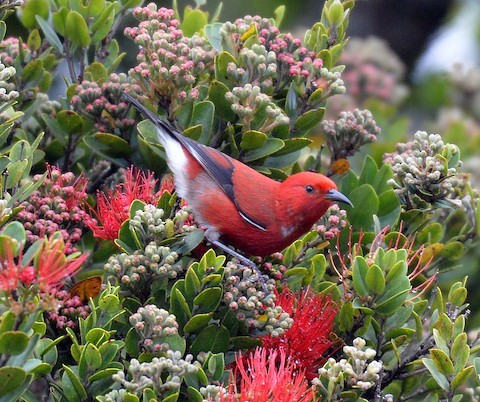
Apapane. (Koke’e State Park, Kauai, Hawaii; March 29, 2016.) © Dan Murphy
Endemic to Hawaii, where it is the most widespread native songbird, inhabiting all six islands with forested highlands. When not breeding, it becomes semi-nomadic in search of flowering trees, sometimes moving from island to island. It is common and conspicuous at montane sites on Kauai, Maui, and the Big Island, less common on Oahu, rare on Molokai, and nearing extirpation on Lanai. On Oahu, it can be found in the hills above Honolulu, including Tantalus Drive, Kuli’ou’ou Valley, and Wiliwilinui and Aiea Ridges, and in the west at Palehua; on Maui, Polipoli Spring, the Waikamoi Preserve, and the Hosmer Grove of Haleakala National Park; on Kauai, Koke’e State Park; and on the Big Island, throughout the highlands.
A mid-sized honeycreeper with a thin, decurved, black bill, and mostly crimson plumage. The wings and tail are black, and the lower belly and undertail coverts are snow-white. Immature plumages are a motley mix of browns, grays, and reds, with black wings and tail.
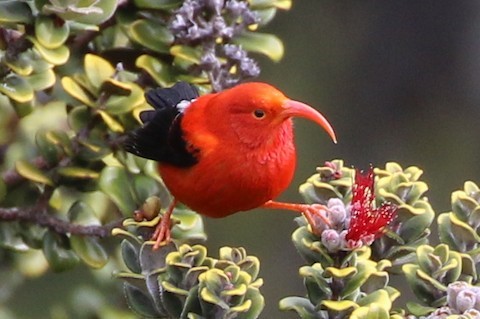
I’iwi. (Hosmer Grove, Haleakala National Park, Maui, Hawaii; December 22, 2019.) © Henggang Cui
Endemic to Hawaii, where it is declining and becoming local and uncommon in upper elevation forests of the Big Island, Maui, and decreasingly on Kauai. Populations on the other islands have declined to the vanishing point, and its continued presence on them may be due to inter-island wandering. On the Big Island it can be found in the kipukas along Saddle Road, Hakalau Forest National Wildlife Refuge, and along the Mauna Loa Strip Road at Hawaii Volcanoes National Park; on Maui, at the Hosmer Grove, Waikamoi Preserve, and Polipoli Spring; and on Kauai at Koke’e State Park. On Oahu most recent reports have been in the Wai’anae Range
Unique: a scarlet honeycreeper with a long, heavy, sickle-shaped coral-pink bill, coral-pink legs, and black wings and tail. Immatures are mostly pale-gray with dark wings and tail and a golden-brown hood.
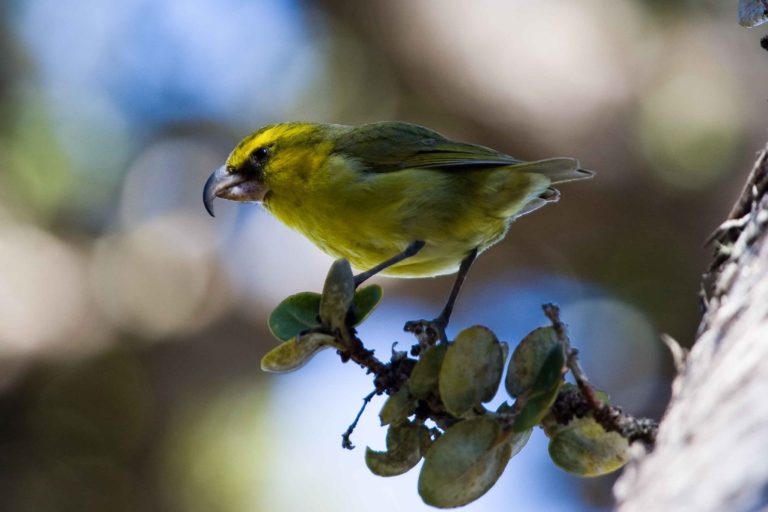
Maui Parrotbill, male. © Robby Kohley
Endemic to Maui, where it is critically endangered, declining, and confined to native forests on the northern and eastern slopes of Mount Haleakala in the range of 1,200 to 2,350 m (mainly 1,500 to 2,100 m) elevation in an effective habitat area of about 40 square kilometers. As of 2020, it can still be found on guided visits to the Waikamoi Preserve.
A plump, olive honeycreeper with a pale eyebrow, a blackish mask, and an outsized, parrotlike bill. Adult male develops a golden flush, strongest on the face, but also on the underparts and wings. Females and immatures are plainer, more gray-olive overall, but also have a variable golden flush on the underparts.
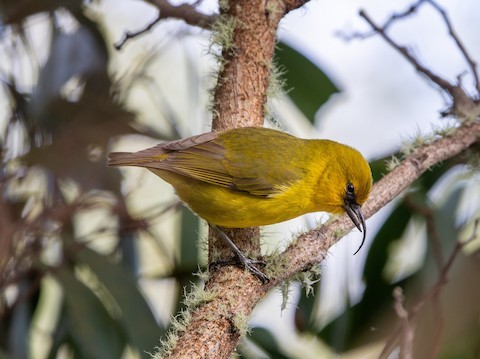
Akiapola’au, male. (Hakalau Forest National Wildlife Refuge, Big Island, Hawaii; January 7, 2020.) © William Higgins
Endemic to the Big Island, where it occurs in native forests in four areas, mainly on the eastern side of the island between about 1,500 and 2,700 m elevation. Although it has vanished from most of its original range, conservation efforts appear to have succeeded in its remaining strongholds. It can be found on tours of the restricted Hakalau Forest National Wildlife Refuge, and fairly consistently on the publicly accessible Pu’u O’o Trail along Saddle Road.
A plump, short-tailed honeycreeper with an extraordinary bill that seems to combine two entirely unrelated tools: a stout, straight, sharp-tipped spike-like lower mandible and a long, thin, delicate, strongly decurved upper mandible. The male is bright-yellow overall, shading to orange on the head and olive on the back, wings, and tail, with a blackish mask. Females and immatures are grayish-olive.
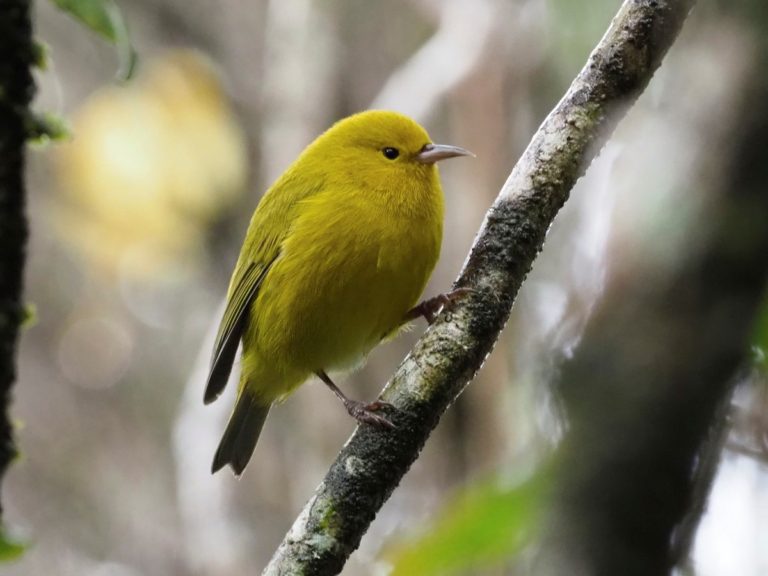
Anianiau, male. (Mohihi-Waiale Trail, Kauai, Hawaii; October 15, 2018.) © Stephan Lorenz
Endemic to Kauai, where it inhabits wet montane forests, mainly in the northwestern portion of the island. Locally common in Koke’e State Park and above, where it can often be found around the Pu’u O Kila Overlook and the Pihea Trail. Formerly occurred at all elevations, but it has generally retreated to areas above 600 m elevation. Along the Na Pali Coast, it has occurred near sea level at least occasionally in recent decades.
A small honeycreeper with pinkish legs and a short, decurved, sharp-tipped, pinkish bill. Male is almost entirely golden-yellow, but darker and more olive on the wings and tail, with white on the belly and undertail coverts. Females and immatures are mostly whitish below and pale grayish-olive above, variably washed with yellow on the head and breast.
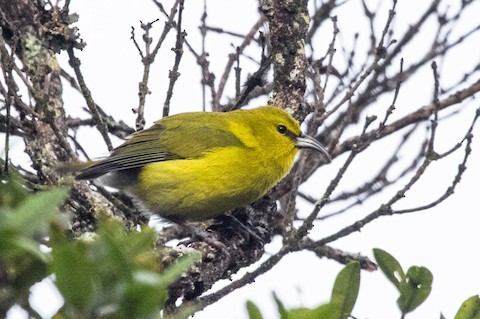
Kauai Amakihi, male. (Pihea Trail, Kauai, Hawaii; January 15, 2016.) © Michael Hooper
Endemic to Kauai, where it inhabits wet montane forests, mainly but not exclusively in the northwestern portion of the island. Locally common in Koke’e State Park and above, where it can be found at the overlooks and along the trails. Formerly occurred at all elevations, but by the mid-1900s it had retreated to areas above 600 m elevation. Still occurs sporadically down to sea level and reported at least occasionally from all portions of the island.
A small yellow-olive honeycreeper with a mid-sized, strongly decurved bill. Male is yellow-olive with a blackish mask and gray in the wings and tail. Females and immatures have a yellow-olive head and breast, a whitish belly, and a mix of yellow-olive and gray on the back, wings, and rump.
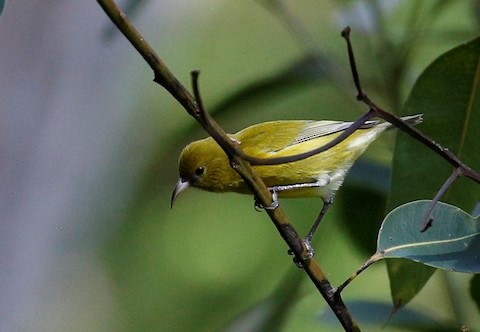
Oahu Amakihi, male. (Aiea Ridge, Oahu, Hawaii; October 12, 2019.) © Laura Keene
Endemic to Oahu, where it occurs throughout the island in forests and other wooded areas, including parks and gardens. After decades of slow decline and retreat into the hills, in the 1980s it began to increase and recolonize lower elevations. It can be found in and around Honolulu at Tantalus Drive, Aiea Ridge, Manoa Falls, Manoa Cliffs, Pu’u Ohia, Wa’ahila Ridge, and Wiliwilinui Ridge, and along Palehua Road in the Nanakuli Forest Reserve.
A small honeycreeper with a short, decurved bill. Male is yellow-olive except for a subtle dark mask and faint whiskers, and brown in the wings and tail. Females and immatures are pale gray, variably washed yellowish or olive, with two distinct wingbars.
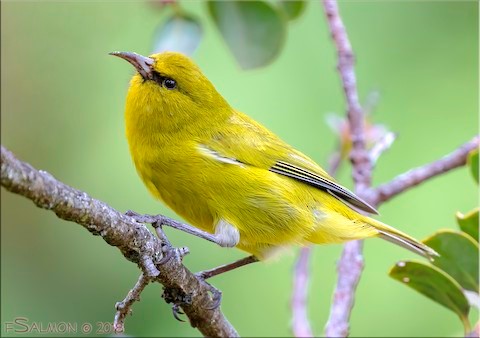
Common Amakihi, C. v. wilsoni, male. (Hosmer Grove, Haleakala National Park, Maui, Hawaii; July 27, 2018.) © Frank Salmon
Endemic to Hawaii, where it is common on Maui and the Big Island, rare on Molokai, and extirpated from Lanai. On Maui it can be found at Polipoli Spring, the Waikamoi Preserve, and the Hosmer Grove of Haleakala National Park. On the Big Island it is generally common and widespread, and can be found at almost all non-coastal sites, but is especially abundant in dry forests and scrub, as at Pu’u La’au and along Saddle Road.
A small honeycreeper with a short, decurved, grayish bill that is remarkably variable in size and shape. Some individuals have thin, delicate bills, while others seem to have much heavier bills. Some have moderately and others deeply curved bills. Male is yellow-olive overall with black lores. Females and immatures are pale gray, variably washed with yellowish or olive.

Hawaii Creeper. (Hakalau Forest National Wildlife Refuge, Big Island, Hawaii; September 17, 2018.) © Bradley Hacker
Endemic to the Big Island, where it occurs in koa and ohia forests, mostly in the band between about 1,500 and 1,900 m elevation. It can be found on tours of the restricted Hakalau Forest National Wildlife Refuge. With some effort and luck, it can also be found at the publicly accessible kipukas along Saddle Road, especially the “3-Mile Kipuka” where the Pu’u O’o Trail and Powerline Road meet.
A small olive-and-gray honeycreeper with a sharp-tipped, conical, slightly decurved, pale bill. Adult plumage is mostly olive above and below, with a blackish mask that contrasts with a pale eyebrow. Immatures are plainer, mostly brownish-gray above and whitish-gray below.

Akeke’e. (Pihea Trail, Kauai, Hawaii; April 15, 2019.) © Jen Sanford
Endemic to Kauai, where it is rare, endangered, and rapidly declining. In the 1990s it remained locally common in Koke’e State Park, and through the 2010s it could still be found with effort and luck along the Pihea Trail, but mostly confined to the Alakai Wilderness. Its trajectory is not promising, having declined from an estimate of 20,650 in the mid-1990s to 945 in 2012.
A small yellow- olive honeycreeper with a sharp-tipped, conical, pale-gray, finchlike bill and a blackish mask. The tail is proportionately long and thin, and deeply notched. The sexes are similar, although males show more contrast.
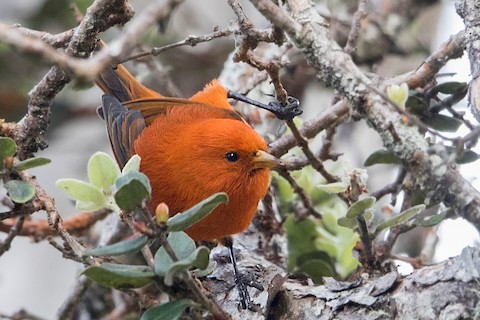
Hawaii Akepa, male. (Hakalau Forest National Wildlife Refuge, Big Island, Hawaii; September 17, 2018.) © Bradley Hacker
Endemic to the Big Island, where it occurs in native forests between about 1,100 and 2,100 m elevation on both the eastern and western sides of the island. It remains locally common in a few areas and can be found on tours of the restricted Hakalau Forest National Wildlife Refuge. With some effort and luck, it can also be found at the publicly accessible “3-Mile Kipuka” south of Saddle Road where the Pu’u O’o Trail and Powerline Road meet.
A small honeycreeper with a sharp-tipped, conical, pale-yellow-to-pinkish, finchlike bill. Definitive male plumage is almost all red, varying from pale orange-red to vermilion, with blackish wings and tail. Females and first-year males are dull-olive above and pale-gray or yellowish below. Second-year males turn red in stages.